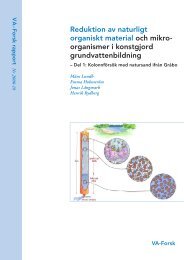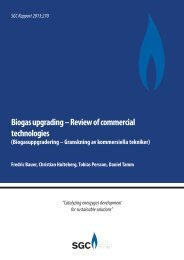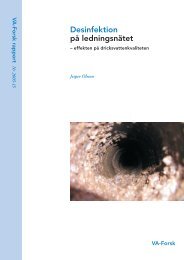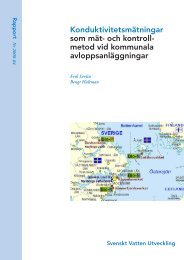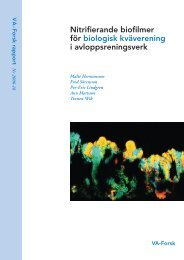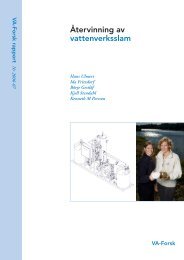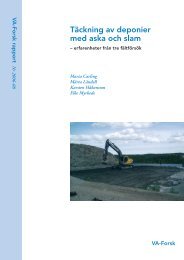Rapport
hjemmesider
hjemmesider
You also want an ePaper? Increase the reach of your titles
YUMPU automatically turns print PDFs into web optimized ePapers that Google loves.
Summary<br />
The aim of this study was to analyze the Swedish research and development<br />
within the area of water and wastewater engineering and specifically the interaction<br />
of Swedish Water and Wastewater Association (SWWA) with its water and<br />
wastewater R&D (W&W R&D).<br />
The extent of Swedish W&W R&D is modest when related to the values that<br />
the water industry in Sweden is managing and especially is the water and wastewater<br />
engineering R&D modest. There are a number of research groups in the<br />
country that are working on water and wastewater issues – so many that several<br />
of them become subcritical in size also leading to suffering of the quality of the<br />
R&D.<br />
The water and wastewater engineering research is dominated by university research<br />
groups. To a lesser extent than in many countries, research is carried out in<br />
independent research institutes. The university research is by nature more basic<br />
than applied. This has resulted in the comprehension within the W&W industry<br />
that Swedish W&W R&D is too theoretical and little applicable for the W&W<br />
industry. This comprehension is, however, not necessarily true.<br />
Swedish research groups within the W&W area are not very active in international<br />
net-works, for instance in projects within EU’s framework programs<br />
for research. Swedish W&W R&D is also to a lesser extent than in many other<br />
countries, innovative with respect to development of new processes and products<br />
for the W&W supply industry. It has been innovative, however, in researching<br />
new systems and concepts that are a result of political and public guidances – for<br />
instance research aiming at ”the recycle society”.<br />
Swedish W&W R&D is more oriented towards W&W treatment technology<br />
than towards W&W systems technology (i.e. pipework technology, net analysis,<br />
storm water technology etc). This is also true for that part of the W&W R&D<br />
that SWWA is financing, which is primarily falling into the category of development<br />
work. This development work is, however, very important for keeping<br />
the wheels rolling in Swedish W&W R&D at this time. But it is far too small<br />
to cover the needs of W&W R&D and will, quite naturally, have a tendency to<br />
become too user-controlled.<br />
There seems to be too little communication between the development work<br />
that is financed by SWWA and the research carried out in the university groups<br />
and in the institutes, which is mainly financed through public and international<br />
funding (Formas, MISTRA, EU etc.).<br />
In order to create a boost in Swedish W&W R&D one has to find a new<br />
model for organization and implementation of W&W R&D in Sweden. Such<br />
a model will have to be based on cooperation between many stakeholders. This<br />
study examines a number of organization- and implementation models that are<br />
in use in other countries and that may give inspiration for creating a sustainable<br />
model in Sweden. The conclusion is, however, that one cannot go for one of these<br />
models, but rather that one has to combine features from several.<br />
A cluster model is proposed. The cluster is named Swedish Water and Wastewater<br />
Research (shortened SVAF in Swedish) and composed of regional centers<br />
(SVAFnorth, SVAFsouth, SVAFeast and SVAFwest) based on the strongest research<br />
groups today and coordinated by one central SVAF managing leadership.<br />
11



